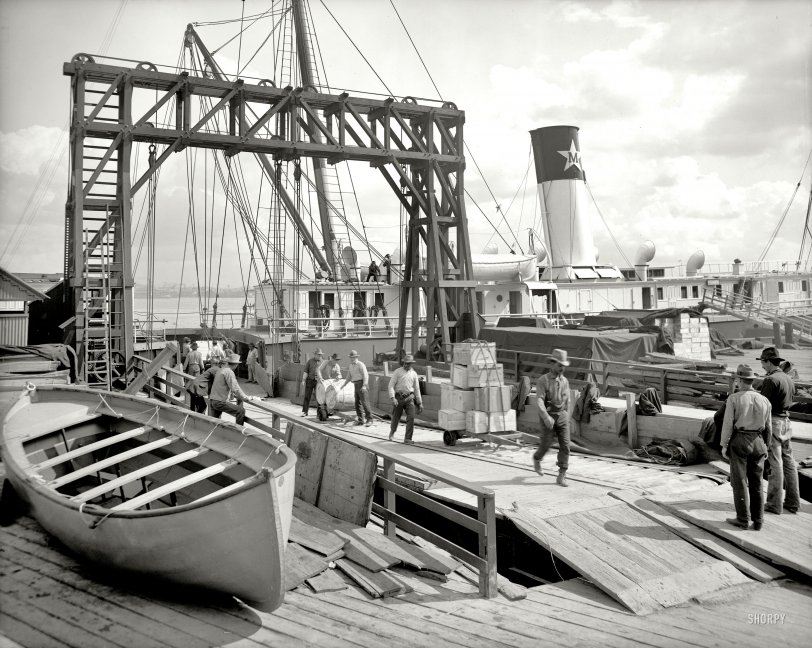


Framed or unframed, desk size to sofa size, printed by us in Arizona and Alabama since 2007. Explore now.
Shorpy is funded by you. Patreon contributors get an ad-free experience.
Learn more.

- Baldwin 62303
- Baldwin VO-1000
- Cold
- No expense spared
- Tough Guys
- Lost in Toyland
- And without gloves
- If I were a blindfolded time traveler
- Smoke Consumer Also Cooks
- Oh that stove!
- Possibly still there?
- What?!?
- $100 Reward
- Freeze Frame
- Texas Flyer wanted
- Just a Year Too Soon
- WWII -- Replacing men with women at the railroad crossing.
- Yes, Icing
- You kids drive me nuts!
- NOT An Easy Job
- I wonder
- Just add window boxes
- Icing Platform?
- Indiana Harbor Belt abides
- Freezing haze
- Corrections (for those who care)
- C&NW at Nelson
- Fallen Flags
- A dangerous job made worse
- Water Stop
Print Emporium
Crate and Barrel: 1906

Circa 1906. "Dock conveyors, New Orleans." On the waterfront along the Mississippi. 8x10 inch glass negative, Detroit Publishing Co. View full size.
Not a walkie-talkie
Sign of the times. I did a double take on that hook handle, it looks so much like a walkie-talkie!
*Click* "Hey Joe, tell the boys to stay off the conveyor if they wanna keep their shoes polished. There's a nasty surprise at the far end!"
And let's hope there's nothing in those barrels that would offend Temperance.
Nifty Hoist
That's called a gantry, I'm sure it is used to lift the end of the bridge the conveyor is on. This allows for the transition of heights of decks of different ships and tidal changes, too. It hinges on the dock end.
The vessel shown
here is the New York, built of iron in 1875 at Wilmington, Delaware, by Harlan & Hollingsworth for Charles Morgan's Morgan Steamship Company. She measured 283 feet in length, powered by the typical triple-expansion steam engine of the day. She was broken up in 1923. Charles Morgan instituted the first steamship line on the American East Coast in 1834. By the time of Morgan's death in 1877, he had amassed quite a transportation empire primarily based on Southern railroads, but of which the steamship company was a prime component. His heirs sold their holdings to C. P. Huntington, who merged them into the Southern Pacific in 1888, but the steamship operation remained known as the Morgan Line until wound up in 1941.
Since Morgan operated a service between Havana and New Orleans at the time this photograph was taken, I suspect the contents of the barrels are either molasses or its potent by-product, rum.
Fancy Apron
The hoist mentioned below, with all the pulleys, is not for handling cargo. The boom on the ship, with its base on the deck-house and its attendant lines rigged to the mast is doing that. Ships of this era were fully capable of loading and unloading themselves in even the most undeveloped port.
The hoist raises and lowers the outboard ends of two aprons fixed to the pier. Thus the aprons (ramps) could be adjusted to any deck height or tidal condition.
Only the apron with the moving belt is in use, and the power seems to be a mystery. A giant hamster-wheel out of view, perhaps. The belt does seem to be valuable enough to justify a long canvas cover to protect it from the weather when not in use.
Details
I noticed the conveyor also, I wonder what powers it? It appears that they are offloading the ship and the conveyor must be capable of running either direction.
The man walking parallel to the conveyor (away from ship) has something stuck in his belt. It's not a radio and too large to be the butt of a pistol?
[It's the handle of a longshoreman's hook. - Dave]

Re: I'm just dying to know
If this were an episode of The Simpsons, all those crates and barrels would be filled to the brim with hot pants.
Machine Age at the docks
Was impressed to note the labor saving conveyor belt moving those hand trucks efficiently along. Comparing the motion blur of people versus belt, that thing offered very little opportunity to rest one's back.
Pretty nifty hoist assembly up above as well. Wonder how that worked? Gotta love those gears.
Those barrels do look provocative, don't they?
I'm just dying to know
What's in those crates and barrels! Any guesses?
























On Shorpy:
Today’s Top 5